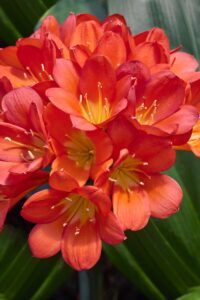 At this time of the year, all the gardening publications are publishing predictions for next year. This is both exciting and intimidating, especially for those of us who are still competing in the great Race against Frost and trying to finish garden clean-up and bulb planting.
At this time of the year, all the gardening publications are publishing predictions for next year. This is both exciting and intimidating, especially for those of us who are still competing in the great Race against Frost and trying to finish garden clean-up and bulb planting.
Glancing through the predictions, one catches my eye—vibrant color palettes. Next year, apparently, gardeners will be looking to amp up the drama in beds, borders, boxes and containers by introducing bright, bold colors. I am considering following suit, even though I am normally a pastel kind of person. An abundance of drama elsewhere in life means that I look to the garden for peace and liberation from headaches. Still, I think that I can probably combine headache/stress relief with a bit of garden liveliness.
The following are a few plants that can add pops of vibrant color in established planting schemes without upsetting the overall garden apple cart.
Blues
For a really bright blue, try Salvia guaranitica, sometimes known as blue anise sage. It is a perennial, but if you live in a cold weather climate, grow it as an annual. The leaves are dark green and alternate on the stems, but the drama in late summer through fall comes from the bright blue to blue-purple flowers. They grow in showy spikes, with elongated blooms that end in pronounced “lips”.
Very few species are truer blue than gentians and everyone, in my opinion, should have them. For a real eye-catcher, try the perennial hybrid Gentiana ‘True Blue’, which grows about 18 inches tall and bears blue, chalice-shaped flowers in summer. It is eminently suitable for both rock gardens, larger containers and the front to middle of borders.
Reds, Oranges and Yellows
Some gardeners blanch at the word “orange” and worry that red flowers absolutely cannot work with other red flowers. Some gardeners also think neon pink and bubble gum pink are obscene—alone or in combination with anything else. Of course, definitions of “obscenity” have changed over the years….
For flashy reds, you can’t do better than cannas, those tall tropicals that shoot up to great heights and bear big, bold leaves and tall spikes of vibrant blooms as long as the weather stays warm. Cannas also come in volcanic orange shades and brilliant yellows. If you are going all in on hot colors, cannas will get you most of the way to your goal. You will have to grow them as annuals, or dig the tubers and store them over the winter, but either option is a small price to pay for a great deal of impact.
For a neat combination of bright color and low levels of commitment, annuals have always been the answer. A realtor that I know swears by combined masses of bright pink and orange impatiens to give “pop” and curb appeal to beds and borders. This option has the added benefit of blooming from the moment the plants are installed through the fall frosts. If you have some shady spots, really bright impatiens will do wonders—even if you are not thinking about selling your house.
When I want flowers that scream “orange” to the waiting world, I think of butterfly weed or Asclepias tuberosa, and Tithonia rotundifolia, sometimes known as Mexican sunflower. Both are also butterfly magnets. Butterfly weed is a perennial member of the milkweed family that grows up to 18 inches tall and bears clusters of small tubular flowers that are perfect for monarch butterflies’ probosces. The plants develop the characteristic milkweed seed pods, which burst open when dry, emitting lots of wispy parachutes that enable the seeds to take flight and travel distances. In my yard, a butterfly weed in the back garden gave birth to a butterfly weed in the front garden with absolutely no help from me. That is the kind of plant self-determination that appeals to me.
Mexican sunflower is a tall annual in the daisy or Compositae family that grows up to four feet tall, with a branching habit. Plant the seeds or starter seedlings in the back of the border, or in the center of a large container. Add water and sunshine and the tithonia will most likely take off. You can also buy yellow-flowered plants, which are almost equally dramatic.
Greens
For screaming greens, I think of plants with lime or chartreuse green flowers or foliage. One year when my daughter was young, she insisted that our garden include a dramatic combination of lime green and bright purple zinnias. The lime green zinnias continued the drama even after the groundhog ate all the purple blooms.
For shady spaces where you may not want to combine pink and orange impatiens, try one of the hostas with lime green lives. The eponymous variety ‘Lime’ will do the job nicely, but there are many varieties to pick from in spring and summer.
As you page through the new garden catalogs and website offerings that start arriving in December, think about the need for brightness in your life and your garden. You don’t have to throw caution to the winds or abandon subtlety next season, just create a few vibrant surprises here and there.
